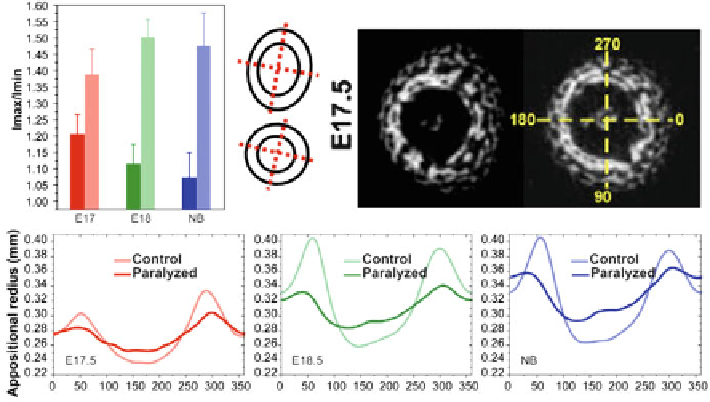Biomedical Engineering Reference
In-Depth Information
Fig. 11.3
(
Top left
) The ratio of the maximum and minimum second moment of inertia was lower
for paralyzed (
darker shade
) compared to control (
lighter shade
) femora (schematics of the
maximum and minimum cross-sectional moment of inertias are shown to the right of the plot
for control (
top
) and paralyzed (
bottom
) mice). (
Top right
) Micro-CT cross-sectional images are
shown for bones from paralyzed (
right
) and control (
left
) mice. (
Bottom
) The appositional radius,
as a function of angular coordinate, is shown for paralyzed and control mice (reproduced, with
permission, from ref. [
66
])
the embryonic stage of development, loss of muscle loading leads to severe
musculoskeletal defects [
62
]. The Huetter-Volkmann law states that in develop-
ing bone, compressive stress reduces the bone growth rate, while tensile loads
accelerate it.
The impact of muscle loading on embryonic development has been examined
in several animal models. Chicken embryos have the advantage of an externally
laid egg and are thus particularly easy to manipulate with chemical paralysis
agents [
63
]. Mice are the most common model of mammalian development and
are well established for genetic manipulations. Mice originally developed to
examine the role of specific genes in development provide useful models of
muscle-less mice. Examples of this include mutations in Pax3 or a combination
of Myf5 and MyoD1, which both result in limbs without skeletal muscle [
64
,
65
].
Muscle contractions
in utero
begin early in embryonic development. The magni-
tude of
in utero
forces increases dramatically when increases in muscle volume
are coupled with the forces that result from bone elongation (Fig.
11.3
)[
66
]. In the
absence of muscle forces, there are defects in bone size, shape, and mineralization
[
63
,
66
-
68
]. Joint cavitation does not occur, leading to bone fusion [
67
]. This is
the result of de-differentiation of joint progenitor cells, which return to a cartilage
phenotype [
69
]. Bone shaping is altered in the absence of muscle loading, with
defects observed in the knee joint, long bone cross-section, and the deltoid
tuberosity [
69
].

Search WWH ::

Custom Search